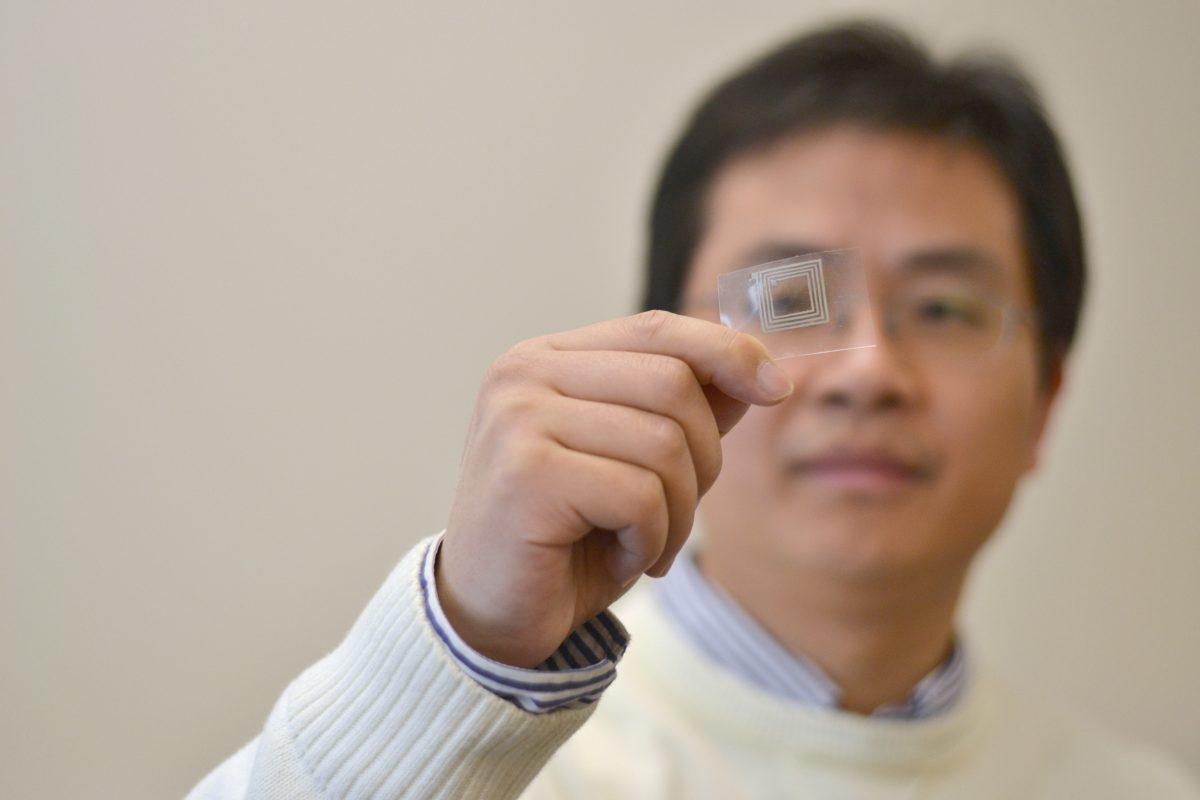 Yong Zhu displays a silver nanosensor prototype he and doctoral student Shanshan Yao have developed. The technology is designed to integrate into wearable devices, such as prosthetics or flexible touch pads to sense motions of the body. " />
Yong Zhu displays a silver nanosensor prototype he and doctoral student Shanshan Yao have developed. The technology is designed to integrate into wearable devices, such as prosthetics or flexible touch pads to sense motions of the body. " />
Photo illustration by Caide Wooten.
Yong Zhu displays a silver nanosensor prototype he and doctoral student Shanshan Yao have developed. The technology is designed to integrate into wearable devices, such as prosthetics or flexible touch pads to sense motions of the body.
When it comes to conducting scientific studies and experiments, reliable data collection is absolutely necessary. To this end, humans have developed sensors to detect and interpret numerous kinds of energy and force. However, sensors have traditionally lacked flexibility.
N.C. State researchers have recently created a sensor that could change that. Yong Zhu, assistant professor of mechanical and aerospace engineering, and Shanshan Yao, graduate student in mechanical engineering, have developed a new sensor utilizing nanowires made of silver that are both extremely sensitive and extremely flexible.
“The sensors are basically capacitors with silver, nanowire-based electrodes and an insulating layer [dielectric] sandwiched in between,” Zhu said. “When the capacitors are stretched and pressed, the capacitance will increase due to dimensional change. When the capacitors are touched by fingers, the fringing electric field is interrupted, leading to the capacitance decrease. By measuring the capacitance changes, the strain, pressure and touch can be detected.”
When the sensor is stretched, bent or pressed, the electric field between the two layers of silver wires is disrupted. The molecules in the dielectric material between them shift positions and increase the capacitance, or how much electric charge it can store, as a result. This is what the measurement device detects.
These sensors are effectively the most flexible sensors to date that manage to maintain a high degree of sensitivity. They are durable enough to be worn on a joint that bends dramatically or applied to a tightly curved surface. They can also be stretched to 150 percent of their original length and retain all of their functionality. All the while, they can detect temperature with a high degree of accuracy. Most previous sensors that have comparable levels of sensitivity would break under such conditions.
The most radical result of these new sensors is what they can be used for. For instance, athletes could wear them and receive instantaneous feedback about the forces and stresses their bodies are undergoing because the sensors display response times in as fast as 40 milliseconds.
“Due to the wearability and quick response, the athletes can also wear such sensors for real-time and long-term monitoring of strain,” Zhu said. “The strain information at the joints could be used to analyze and improve athletes’ performances.”
They could also be incorporated directly into clothing rather than attached to the skin. These articles of clothing could be used to monitor a person’s movements or even their health in real time.
Most promising are the uses in the biomedical field and that these sensors are simple and inexpensive to make.
“The sensors could be mounted onto prosthetics and robots as artificial skin, giving them multiple sensibilities,” Zhu said. “In another way, the sensors could measure strain, pressure or finger touch from humans, which might be used as biosignals sent to prosthetic or robotic devices for motion control.”
In the near future, there could be prosthetic limbs the user could actually feel. Similarly, robots with sensory capabilities similar to that of humans could be created, which could instantaneously receive feedback about their environment and actions.
“The advantages of our wearable sensors are that they’re mechanically robust and their wearability,” Zhu said. “They could be wrapped onto nonplanar and dynamic surfaces, which is crucial for biomedical applications.
“In addition, highly stretchable sensors enable large deformation sensing capability. For example, the strain associated with human movement can be as high as 50 percent, far beyond the capability of traditional strain sensors. But our sensors can accommodate and measure such high strain,” Zhu said.
It may not be readily apparent, but sensors are a vital part of the continual effort to advance technology. However, sometimes the sensor itself is what needs advancement, and that is precisely what Zhu and Yao have provided.